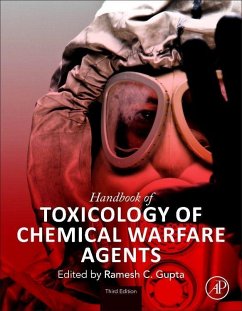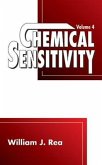Handbook of Toxicology of Chemical Warfare Agents
Herausgeber: Gupta, Ramesh C
Handbook of Toxicology of Chemical Warfare Agents
Herausgeber: Gupta, Ramesh C
- Gebundenes Buch
- Merkliste
- Auf die Merkliste
- Bewerten Bewerten
- Teilen
- Produkt teilen
- Produkterinnerung
- Produkterinnerung
Provides a comprehensive overview of key topics both on the theoretical side and the experimental Discusses important properties that impact metal oxide performance, processing methods (both novel and accepted), and important applications Reviews the most relevant applications, such as biomedical, energy, electronics and materials applications
Andere Kunden interessierten sich auch für
![Chemical Sensitivity Chemical Sensitivity]() William J. ReaChemical Sensitivity256,99 €
William J. ReaChemical Sensitivity256,99 €![Chemical Warfare Agents Chemical Warfare Agents]() Timothy C. Marrs (ed.)Chemical Warfare Agents520,99 €
Timothy C. Marrs (ed.)Chemical Warfare Agents520,99 €![Biological Effects of Low Level Exposures to Chemical and Radiation Biological Effects of Low Level Exposures to Chemical and Radiation]() Biological Effects of Low Level Exposures to Chemical and Radiation134,99 €
Biological Effects of Low Level Exposures to Chemical and Radiation134,99 €![Biomarkers in Toxicology Biomarkers in Toxicology]() Biomarkers in Toxicology292,99 €
Biomarkers in Toxicology292,99 €![Toxicology of the Human Environment Toxicology of the Human Environment]() Toxicology of the Human Environment256,99 €
Toxicology of the Human Environment256,99 €![Toxicology of Amphibian Tadpoles Toxicology of Amphibian Tadpoles]() Toxicology of Amphibian Tadpoles156,99 €
Toxicology of Amphibian Tadpoles156,99 €![Tobacco-Specific N-Nitrosamines Recent Advances Tobacco-Specific N-Nitrosamines Recent Advances]() Roger O. McClellanTobacco-Specific N-Nitrosamines Recent Advances157,99 €
Roger O. McClellanTobacco-Specific N-Nitrosamines Recent Advances157,99 €-
-
-
Provides a comprehensive overview of key topics both on the theoretical side and the experimental Discusses important properties that impact metal oxide performance, processing methods (both novel and accepted), and important applications Reviews the most relevant applications, such as biomedical, energy, electronics and materials applications
Hinweis: Dieser Artikel kann nur an eine deutsche Lieferadresse ausgeliefert werden.
Hinweis: Dieser Artikel kann nur an eine deutsche Lieferadresse ausgeliefert werden.
Produktdetails
- Produktdetails
- Verlag: Elsevier Science
- 3rd edition
- Seitenzahl: 1318
- Erscheinungstermin: 27. April 2020
- Englisch
- Abmessung: 279mm x 221mm x 54mm
- Gewicht: 2912g
- ISBN-13: 9780128190906
- ISBN-10: 0128190906
- Artikelnr.: 58411615
- Herstellerkennzeichnung
- Libri GmbH
- Europaallee 1
- 36244 Bad Hersfeld
- 06621 890
- Verlag: Elsevier Science
- 3rd edition
- Seitenzahl: 1318
- Erscheinungstermin: 27. April 2020
- Englisch
- Abmessung: 279mm x 221mm x 54mm
- Gewicht: 2912g
- ISBN-13: 9780128190906
- ISBN-10: 0128190906
- Artikelnr.: 58411615
- Herstellerkennzeichnung
- Libri GmbH
- Europaallee 1
- 36244 Bad Hersfeld
- 06621 890
Section I: Historical Perspective and Epidemiology
1. History of Toxicology: From Killers to Healers; 2. Historical
Perspective of Chemical Warfare Agents; 3. Global Impact of Chemical
Warfare Agents Used Before and After 1945; 4. Sarin Attacks in Japan: Acute
and Delayed Health Effects in Survivors; 5. Early and Delayed Effects of
Sulfur Mustard in Iranian Veterans After the Iraq-Iran Conflict; 6.
Epidemiology of Chemical Warfare Agents; 7. Chemical Weapons of Mass
Destruction and Terrorism: A Threat Analysis
Section II: Agents That Can Be Used as Weapons of Mass Destruction
8. Organophosphate Nerve Agents; 9. Russian VX; 10. Novichoks; 11. Blister
Agents; 12. Riot Control Agents; 13. Phosgene oxime; 14. Psychotomimetic
Agent BZ (3-Quinuclidinyl Benzilate); 15. Fluoroacetate; 16. Strychnine;
17. Superwarfarins; 18. PCBs, Dioxins and Furans: Human Exposure and Health
Effects; 19. Polycyclic Aromatic Hydrocarbons: Implications for
Developmental, Molecular, and Behavioral Neurotoxicity; 20. Thallium; 21.
Arsenicals: Toxicity, Their Use as Chemical Warfare Agents, and Possible
Remedial Measures; 22. Chlorine; 23. Phosgene; 24. Carbon Monoxide: Can't
See, Can't Smell, Body Looks Red But They Are Dead; 25. Acute Cyanide
Toxicity and its Treatment: The Body is Dead and Maybe Red but Does Not
Stay Red for Long; 26. Methyl Isocyanate: The Bhopal Gas; 27. Other Toxic
Chemicals as Potential Chemical Warfare Agents; 28. Ricin; 29. Botulinum
Toxin; 30. Onchidal and Fasciculins; 31. Cyanobacterial (Blue-Green Algae)
Toxins
Section III: Target Organ Toxicity
32. Chemical Warfare Agents and the Nervous System; 33. Behavioral Toxicity
of Nerve Agents; 34. The Respiratory Toxicity of Chemical Warfare Agents;
35. Cardiovascular System as a Target of Chemical Warfare Agents; 36.
Ocular Toxicity of Chemical Warfare Agents; 37. Skeletal Muscle; 38. Dermal
Toxicity of Sulfur Mustard; 39. Reproductive Toxicity and Endocrine
Disruption of Potential Chemical Warfare Agents; 40. Liver Toxicity of
Chemical Warfare Agents; 41. Renal System; 42. Impact of Chemical Warfare
Agents on the Immune System
Section IV: Special Topics
43. Health Effects of Nuclear Weapons and Releases of Radioactive
Materials; 44. Clinical and Cellular Aspects of Traumatic Brain Injury; 45.
Neurological Effects and Mechanisms of Blast Overpressure Injury; 46.
Genomics and Proteomics in Brain Complexity in Relation to
Chemically-Induced PTSD; 47. Excitotoxicity, Oxidative Stress, and Neuronal
Injury; 48. Blood-Brain Barrier Damage and Dysfunction by Chemical
Toxicity; 49. The Effects of Organophosphates in the Early Stages of Human
Skeletal Muscle Regeneration; 50. Experimental modeling for delayed effects
of organophosphates; 51. Alternative Animal Toxicity Testing of Chemical
Warfare Agents
Section V: Toxicokinetics, Toxicodynamics and Physiologically-Based
Pharmacokinetics
52. Toxicokinetic Aspects of Nerve Agents and Vesicants; 53. Toxicokinetics
and Toxicodynamics of DFP; 54. Physiologically Based Pharmacokinetic
Modeling of Chemical Warfare Agents; 55. Biotransformation of Warfare Nerve
Agents
Section VI: Analytical Methods, Biosensors and Biomarkers
56. Laboratory Analysis of Chemical Warfare Agents, Adducts, and
Metabolites in Biomedical Samples; 57. On-Site Detection of Chemical
Warfare Agents; 58. Neuropathy Target Esterase as a Biomarker and Biosensor
of Delayed Neuropathic Agents; 59. The crosslinking action of
organophosphorus poisons; implications for chronic neurotoxicity; 60.
Monitoring of Blood Cholinesterase Activity in Workers Exposed to Nerve
Agents
Section VII: Risks to Animals and Wildlife
61. Potential Agents That Can Cause Contamination of Animal Feed stuff and
Terror; 62. Chemical Warfare Agents and Risks to Animal Health; 63. Threats
to Wildlife by Chemical and Warfare Agents
Section VIII: Emergency Preparedness, Prophylactic, Therapeutic and
Countermeasures
64. Pharmacological Prophylaxis Against Nerve Agent Poisoning: Experimental
Studies and Practical Implications;
65. Prophylactic and Therapeutic Measures in Nerve Agents Poisoning; 66.
Physiologically Based Pharmacokinetic/Pharmacodynamic Modeling of
Countermeasures to Nerve Agents; 67. Research on Medical Countermeasures
for Chemical Attacks on Civilians; 68. Pyridinium Oximes in the Treatment
of Poisoning with Organophosphorus Compounds; 69. Novel Cholinesterase
Reactivators; 70. Paraoxonase (PON1), detoxication of nerve agents, and
modulation of their toxicity; 71. The role of carboxylesterases in
therapeutic interventions of nerve agent poisoning; 72. Catalytic
bioscavengers: the new generation of bioscavenger-based medical
countermeasures
Section IX: Decontamination and Detoxification
73. Rapid Decontamination of Chemical Warfare Agents from the Skin
1. History of Toxicology: From Killers to Healers; 2. Historical
Perspective of Chemical Warfare Agents; 3. Global Impact of Chemical
Warfare Agents Used Before and After 1945; 4. Sarin Attacks in Japan: Acute
and Delayed Health Effects in Survivors; 5. Early and Delayed Effects of
Sulfur Mustard in Iranian Veterans After the Iraq-Iran Conflict; 6.
Epidemiology of Chemical Warfare Agents; 7. Chemical Weapons of Mass
Destruction and Terrorism: A Threat Analysis
Section II: Agents That Can Be Used as Weapons of Mass Destruction
8. Organophosphate Nerve Agents; 9. Russian VX; 10. Novichoks; 11. Blister
Agents; 12. Riot Control Agents; 13. Phosgene oxime; 14. Psychotomimetic
Agent BZ (3-Quinuclidinyl Benzilate); 15. Fluoroacetate; 16. Strychnine;
17. Superwarfarins; 18. PCBs, Dioxins and Furans: Human Exposure and Health
Effects; 19. Polycyclic Aromatic Hydrocarbons: Implications for
Developmental, Molecular, and Behavioral Neurotoxicity; 20. Thallium; 21.
Arsenicals: Toxicity, Their Use as Chemical Warfare Agents, and Possible
Remedial Measures; 22. Chlorine; 23. Phosgene; 24. Carbon Monoxide: Can't
See, Can't Smell, Body Looks Red But They Are Dead; 25. Acute Cyanide
Toxicity and its Treatment: The Body is Dead and Maybe Red but Does Not
Stay Red for Long; 26. Methyl Isocyanate: The Bhopal Gas; 27. Other Toxic
Chemicals as Potential Chemical Warfare Agents; 28. Ricin; 29. Botulinum
Toxin; 30. Onchidal and Fasciculins; 31. Cyanobacterial (Blue-Green Algae)
Toxins
Section III: Target Organ Toxicity
32. Chemical Warfare Agents and the Nervous System; 33. Behavioral Toxicity
of Nerve Agents; 34. The Respiratory Toxicity of Chemical Warfare Agents;
35. Cardiovascular System as a Target of Chemical Warfare Agents; 36.
Ocular Toxicity of Chemical Warfare Agents; 37. Skeletal Muscle; 38. Dermal
Toxicity of Sulfur Mustard; 39. Reproductive Toxicity and Endocrine
Disruption of Potential Chemical Warfare Agents; 40. Liver Toxicity of
Chemical Warfare Agents; 41. Renal System; 42. Impact of Chemical Warfare
Agents on the Immune System
Section IV: Special Topics
43. Health Effects of Nuclear Weapons and Releases of Radioactive
Materials; 44. Clinical and Cellular Aspects of Traumatic Brain Injury; 45.
Neurological Effects and Mechanisms of Blast Overpressure Injury; 46.
Genomics and Proteomics in Brain Complexity in Relation to
Chemically-Induced PTSD; 47. Excitotoxicity, Oxidative Stress, and Neuronal
Injury; 48. Blood-Brain Barrier Damage and Dysfunction by Chemical
Toxicity; 49. The Effects of Organophosphates in the Early Stages of Human
Skeletal Muscle Regeneration; 50. Experimental modeling for delayed effects
of organophosphates; 51. Alternative Animal Toxicity Testing of Chemical
Warfare Agents
Section V: Toxicokinetics, Toxicodynamics and Physiologically-Based
Pharmacokinetics
52. Toxicokinetic Aspects of Nerve Agents and Vesicants; 53. Toxicokinetics
and Toxicodynamics of DFP; 54. Physiologically Based Pharmacokinetic
Modeling of Chemical Warfare Agents; 55. Biotransformation of Warfare Nerve
Agents
Section VI: Analytical Methods, Biosensors and Biomarkers
56. Laboratory Analysis of Chemical Warfare Agents, Adducts, and
Metabolites in Biomedical Samples; 57. On-Site Detection of Chemical
Warfare Agents; 58. Neuropathy Target Esterase as a Biomarker and Biosensor
of Delayed Neuropathic Agents; 59. The crosslinking action of
organophosphorus poisons; implications for chronic neurotoxicity; 60.
Monitoring of Blood Cholinesterase Activity in Workers Exposed to Nerve
Agents
Section VII: Risks to Animals and Wildlife
61. Potential Agents That Can Cause Contamination of Animal Feed stuff and
Terror; 62. Chemical Warfare Agents and Risks to Animal Health; 63. Threats
to Wildlife by Chemical and Warfare Agents
Section VIII: Emergency Preparedness, Prophylactic, Therapeutic and
Countermeasures
64. Pharmacological Prophylaxis Against Nerve Agent Poisoning: Experimental
Studies and Practical Implications;
65. Prophylactic and Therapeutic Measures in Nerve Agents Poisoning; 66.
Physiologically Based Pharmacokinetic/Pharmacodynamic Modeling of
Countermeasures to Nerve Agents; 67. Research on Medical Countermeasures
for Chemical Attacks on Civilians; 68. Pyridinium Oximes in the Treatment
of Poisoning with Organophosphorus Compounds; 69. Novel Cholinesterase
Reactivators; 70. Paraoxonase (PON1), detoxication of nerve agents, and
modulation of their toxicity; 71. The role of carboxylesterases in
therapeutic interventions of nerve agent poisoning; 72. Catalytic
bioscavengers: the new generation of bioscavenger-based medical
countermeasures
Section IX: Decontamination and Detoxification
73. Rapid Decontamination of Chemical Warfare Agents from the Skin
Section I: Historical Perspective and Epidemiology
1. History of Toxicology: From Killers to Healers; 2. Historical
Perspective of Chemical Warfare Agents; 3. Global Impact of Chemical
Warfare Agents Used Before and After 1945; 4. Sarin Attacks in Japan: Acute
and Delayed Health Effects in Survivors; 5. Early and Delayed Effects of
Sulfur Mustard in Iranian Veterans After the Iraq-Iran Conflict; 6.
Epidemiology of Chemical Warfare Agents; 7. Chemical Weapons of Mass
Destruction and Terrorism: A Threat Analysis
Section II: Agents That Can Be Used as Weapons of Mass Destruction
8. Organophosphate Nerve Agents; 9. Russian VX; 10. Novichoks; 11. Blister
Agents; 12. Riot Control Agents; 13. Phosgene oxime; 14. Psychotomimetic
Agent BZ (3-Quinuclidinyl Benzilate); 15. Fluoroacetate; 16. Strychnine;
17. Superwarfarins; 18. PCBs, Dioxins and Furans: Human Exposure and Health
Effects; 19. Polycyclic Aromatic Hydrocarbons: Implications for
Developmental, Molecular, and Behavioral Neurotoxicity; 20. Thallium; 21.
Arsenicals: Toxicity, Their Use as Chemical Warfare Agents, and Possible
Remedial Measures; 22. Chlorine; 23. Phosgene; 24. Carbon Monoxide: Can't
See, Can't Smell, Body Looks Red But They Are Dead; 25. Acute Cyanide
Toxicity and its Treatment: The Body is Dead and Maybe Red but Does Not
Stay Red for Long; 26. Methyl Isocyanate: The Bhopal Gas; 27. Other Toxic
Chemicals as Potential Chemical Warfare Agents; 28. Ricin; 29. Botulinum
Toxin; 30. Onchidal and Fasciculins; 31. Cyanobacterial (Blue-Green Algae)
Toxins
Section III: Target Organ Toxicity
32. Chemical Warfare Agents and the Nervous System; 33. Behavioral Toxicity
of Nerve Agents; 34. The Respiratory Toxicity of Chemical Warfare Agents;
35. Cardiovascular System as a Target of Chemical Warfare Agents; 36.
Ocular Toxicity of Chemical Warfare Agents; 37. Skeletal Muscle; 38. Dermal
Toxicity of Sulfur Mustard; 39. Reproductive Toxicity and Endocrine
Disruption of Potential Chemical Warfare Agents; 40. Liver Toxicity of
Chemical Warfare Agents; 41. Renal System; 42. Impact of Chemical Warfare
Agents on the Immune System
Section IV: Special Topics
43. Health Effects of Nuclear Weapons and Releases of Radioactive
Materials; 44. Clinical and Cellular Aspects of Traumatic Brain Injury; 45.
Neurological Effects and Mechanisms of Blast Overpressure Injury; 46.
Genomics and Proteomics in Brain Complexity in Relation to
Chemically-Induced PTSD; 47. Excitotoxicity, Oxidative Stress, and Neuronal
Injury; 48. Blood-Brain Barrier Damage and Dysfunction by Chemical
Toxicity; 49. The Effects of Organophosphates in the Early Stages of Human
Skeletal Muscle Regeneration; 50. Experimental modeling for delayed effects
of organophosphates; 51. Alternative Animal Toxicity Testing of Chemical
Warfare Agents
Section V: Toxicokinetics, Toxicodynamics and Physiologically-Based
Pharmacokinetics
52. Toxicokinetic Aspects of Nerve Agents and Vesicants; 53. Toxicokinetics
and Toxicodynamics of DFP; 54. Physiologically Based Pharmacokinetic
Modeling of Chemical Warfare Agents; 55. Biotransformation of Warfare Nerve
Agents
Section VI: Analytical Methods, Biosensors and Biomarkers
56. Laboratory Analysis of Chemical Warfare Agents, Adducts, and
Metabolites in Biomedical Samples; 57. On-Site Detection of Chemical
Warfare Agents; 58. Neuropathy Target Esterase as a Biomarker and Biosensor
of Delayed Neuropathic Agents; 59. The crosslinking action of
organophosphorus poisons; implications for chronic neurotoxicity; 60.
Monitoring of Blood Cholinesterase Activity in Workers Exposed to Nerve
Agents
Section VII: Risks to Animals and Wildlife
61. Potential Agents That Can Cause Contamination of Animal Feed stuff and
Terror; 62. Chemical Warfare Agents and Risks to Animal Health; 63. Threats
to Wildlife by Chemical and Warfare Agents
Section VIII: Emergency Preparedness, Prophylactic, Therapeutic and
Countermeasures
64. Pharmacological Prophylaxis Against Nerve Agent Poisoning: Experimental
Studies and Practical Implications;
65. Prophylactic and Therapeutic Measures in Nerve Agents Poisoning; 66.
Physiologically Based Pharmacokinetic/Pharmacodynamic Modeling of
Countermeasures to Nerve Agents; 67. Research on Medical Countermeasures
for Chemical Attacks on Civilians; 68. Pyridinium Oximes in the Treatment
of Poisoning with Organophosphorus Compounds; 69. Novel Cholinesterase
Reactivators; 70. Paraoxonase (PON1), detoxication of nerve agents, and
modulation of their toxicity; 71. The role of carboxylesterases in
therapeutic interventions of nerve agent poisoning; 72. Catalytic
bioscavengers: the new generation of bioscavenger-based medical
countermeasures
Section IX: Decontamination and Detoxification
73. Rapid Decontamination of Chemical Warfare Agents from the Skin
1. History of Toxicology: From Killers to Healers; 2. Historical
Perspective of Chemical Warfare Agents; 3. Global Impact of Chemical
Warfare Agents Used Before and After 1945; 4. Sarin Attacks in Japan: Acute
and Delayed Health Effects in Survivors; 5. Early and Delayed Effects of
Sulfur Mustard in Iranian Veterans After the Iraq-Iran Conflict; 6.
Epidemiology of Chemical Warfare Agents; 7. Chemical Weapons of Mass
Destruction and Terrorism: A Threat Analysis
Section II: Agents That Can Be Used as Weapons of Mass Destruction
8. Organophosphate Nerve Agents; 9. Russian VX; 10. Novichoks; 11. Blister
Agents; 12. Riot Control Agents; 13. Phosgene oxime; 14. Psychotomimetic
Agent BZ (3-Quinuclidinyl Benzilate); 15. Fluoroacetate; 16. Strychnine;
17. Superwarfarins; 18. PCBs, Dioxins and Furans: Human Exposure and Health
Effects; 19. Polycyclic Aromatic Hydrocarbons: Implications for
Developmental, Molecular, and Behavioral Neurotoxicity; 20. Thallium; 21.
Arsenicals: Toxicity, Their Use as Chemical Warfare Agents, and Possible
Remedial Measures; 22. Chlorine; 23. Phosgene; 24. Carbon Monoxide: Can't
See, Can't Smell, Body Looks Red But They Are Dead; 25. Acute Cyanide
Toxicity and its Treatment: The Body is Dead and Maybe Red but Does Not
Stay Red for Long; 26. Methyl Isocyanate: The Bhopal Gas; 27. Other Toxic
Chemicals as Potential Chemical Warfare Agents; 28. Ricin; 29. Botulinum
Toxin; 30. Onchidal and Fasciculins; 31. Cyanobacterial (Blue-Green Algae)
Toxins
Section III: Target Organ Toxicity
32. Chemical Warfare Agents and the Nervous System; 33. Behavioral Toxicity
of Nerve Agents; 34. The Respiratory Toxicity of Chemical Warfare Agents;
35. Cardiovascular System as a Target of Chemical Warfare Agents; 36.
Ocular Toxicity of Chemical Warfare Agents; 37. Skeletal Muscle; 38. Dermal
Toxicity of Sulfur Mustard; 39. Reproductive Toxicity and Endocrine
Disruption of Potential Chemical Warfare Agents; 40. Liver Toxicity of
Chemical Warfare Agents; 41. Renal System; 42. Impact of Chemical Warfare
Agents on the Immune System
Section IV: Special Topics
43. Health Effects of Nuclear Weapons and Releases of Radioactive
Materials; 44. Clinical and Cellular Aspects of Traumatic Brain Injury; 45.
Neurological Effects and Mechanisms of Blast Overpressure Injury; 46.
Genomics and Proteomics in Brain Complexity in Relation to
Chemically-Induced PTSD; 47. Excitotoxicity, Oxidative Stress, and Neuronal
Injury; 48. Blood-Brain Barrier Damage and Dysfunction by Chemical
Toxicity; 49. The Effects of Organophosphates in the Early Stages of Human
Skeletal Muscle Regeneration; 50. Experimental modeling for delayed effects
of organophosphates; 51. Alternative Animal Toxicity Testing of Chemical
Warfare Agents
Section V: Toxicokinetics, Toxicodynamics and Physiologically-Based
Pharmacokinetics
52. Toxicokinetic Aspects of Nerve Agents and Vesicants; 53. Toxicokinetics
and Toxicodynamics of DFP; 54. Physiologically Based Pharmacokinetic
Modeling of Chemical Warfare Agents; 55. Biotransformation of Warfare Nerve
Agents
Section VI: Analytical Methods, Biosensors and Biomarkers
56. Laboratory Analysis of Chemical Warfare Agents, Adducts, and
Metabolites in Biomedical Samples; 57. On-Site Detection of Chemical
Warfare Agents; 58. Neuropathy Target Esterase as a Biomarker and Biosensor
of Delayed Neuropathic Agents; 59. The crosslinking action of
organophosphorus poisons; implications for chronic neurotoxicity; 60.
Monitoring of Blood Cholinesterase Activity in Workers Exposed to Nerve
Agents
Section VII: Risks to Animals and Wildlife
61. Potential Agents That Can Cause Contamination of Animal Feed stuff and
Terror; 62. Chemical Warfare Agents and Risks to Animal Health; 63. Threats
to Wildlife by Chemical and Warfare Agents
Section VIII: Emergency Preparedness, Prophylactic, Therapeutic and
Countermeasures
64. Pharmacological Prophylaxis Against Nerve Agent Poisoning: Experimental
Studies and Practical Implications;
65. Prophylactic and Therapeutic Measures in Nerve Agents Poisoning; 66.
Physiologically Based Pharmacokinetic/Pharmacodynamic Modeling of
Countermeasures to Nerve Agents; 67. Research on Medical Countermeasures
for Chemical Attacks on Civilians; 68. Pyridinium Oximes in the Treatment
of Poisoning with Organophosphorus Compounds; 69. Novel Cholinesterase
Reactivators; 70. Paraoxonase (PON1), detoxication of nerve agents, and
modulation of their toxicity; 71. The role of carboxylesterases in
therapeutic interventions of nerve agent poisoning; 72. Catalytic
bioscavengers: the new generation of bioscavenger-based medical
countermeasures
Section IX: Decontamination and Detoxification
73. Rapid Decontamination of Chemical Warfare Agents from the Skin








